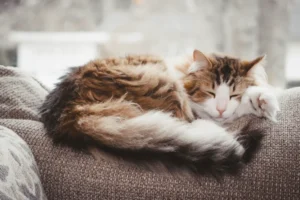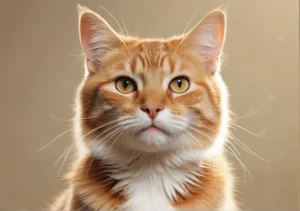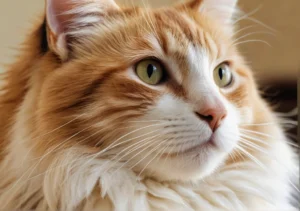Cats can be some of the most intriguing companions, but when they start to seem restless, it raises a flag of curiosity. Watching your feline friend pace, meow incessantly, or act out of sorts can be puzzling—what’s behind that quirky behavior?
Restlessness in cats can stem from various factors, including stress, boredom, health issues, or even a need for more stimulation. Identifying the root cause is key to restoring your cat’s tranquility.
What are common signs of restlessness in cats?
Restlessness in cats can manifest in several ways, each reflecting their need for comfort or stimulation. Pacing around the house is a primary sign; if your kitty can’t seem to settle in one spot, that’s worth noting. Vocalization is another indicator—persistent meowing or yowling might mean they’re feeling anxious or bored.
You might also catch them scratching at furniture or objects or even chasing invisible prey—a typical behavior when they’re bored or seeking something to engage with. Further, a cat that’s hiding or avoiding interaction might be trying to escape a chaotic environment or feeling overwhelmed. Lastly, excessive grooming can be a red flag, as cats may over-clean themselves when they’re stressed or agitated.
Keep an eye out for these behaviors, as they can be your cat’s way of communicating discomfort or a need for change in their environment.
Could my cat be bored?
Boredom is a sneaky culprit behind that restless behavior. Cats thrive on stimulation and engagement—both mentally and physically. If your feline friend isn’t getting enough of either, it could lead to restlessness and unwanted behaviors. Think about it: are they spending too much time alone, or is their environment lacking excitement?
Here are some signs that boredom might be at play:
- Lack of Play: If your cat isn’t interested in chasing toys or playing, boredom might be a factor.
- Destructive Behavior: Scratching furniture, knocking things over, or chewing on inappropriate items can signal they’re looking for something to do.
- Excessive Sleeping: While cats love their naps, an increase in sleep duration can signal a lack of stimulation.
To tackle boredom, consider these fun ideas:
- Rotate Toys: Keep things fresh by regularly swapping out your cat’s toys. It rekindles their interest and encourages play.
- Interactive Games: Invest in puzzle toys that challenge them mentally. It stimulates their problem-solving skills and keeps them engaged.
- Create High Spaces: Cats love to perch up high—adding shelves or cat trees can make their environment more exciting.
Don’t forget, regular playtime with you is crucial, too! Beyond the playful pursuits, consider introducing new scents—like catnip-filled toys—to spark their curiosity. For more insights, check out the ASPCA’s approach to cat enrichment here. Even small changes can work wonders for your kitty’s mood.
Is my cat feeling stressed?
Restlessness in cats often signals some underlying stress. Cats are sensitive creatures, and their environment can play a huge role in their emotional well-being. Sudden changes like moving to a new home, the addition of new pets or family members, or even rearranging furniture can induce stress.
Common sources of stress include:
- Loud noises: Fireworks, thunderstorms, or even loud household appliances can unsettle a cat.
- Lack of stimulation: Cats need mental and physical stimulation. A dull environment may leave your kitty feeling anxious.
- Conflict: If there are other pets around, clashes over territory can trigger unease.
- Change in routine: Cats thrive on routine. Changes in feeding times or your daily patterns can throw them off.
Pay attention to those little signs, like excessive grooming or hiding, which often accompany stress. Making small changes to their environment—like adding cozy spots, interactive toys, or calming pheromone diffusers—can help soothe a restless cat.
Could health issues be at play?
Restlessness in cats might not just stem from environmental stressors; health concerns could also be at fault. It’s crucial to keep a close eye on any changes in behavior, as they can indicate underlying medical issues.
Common health issues that might cause restlessness include:
- Pain or discomfort: Conditions like arthritis or dental problems can lead to discomfort, making your cat more restless.
- Hyperthyroidism: This hormone imbalance can result in increased activity levels and anxiety.
- Feline Lower Urinary Tract Disease (FLUTD): Cats suffering from this condition often exhibit signs of distress while struggling with painful urination.
- Infections or illnesses: Ear infections, parasites, or other health problems can cause irritability and restlessness.
If you’ve noticed unusual behavior along with your cat’s restlessness, a trip to the vet is a smart idea. They can provide valuable insights and run tests to rule out medical concerns. For more information on cat health, check out the American Association of Feline Practitioners.
Cats can’t tell us what’s wrong, so staying alert to their needs is key. Whether it’s environmental stress or health issues, understanding the root of your cat’s unease can lead to a happier home for both of you.
How can I provide better stimulation for my cat?
Cats thrive on mental and physical stimulation, and a lack of either can lead to restlessness. Start by creating a dynamic environment filled with engaging toys. Consider the following strategies:
Interactive toys : Invest in toys that require your cat to think, like puzzle feeders or treat-dispensing balls. These can provide both mental engagement and a tasty reward.
Playtime : Schedule daily play sessions using wand toys or laser pointers. Aim for at least 15 to 20 minutes of active play to help burn off excess energy.
Vertical spaces : Cats love to climb. Adding cat trees, shelves, or window perches gives them a place to explore and survey their territory.
Hideaways : Cats appreciate safe spots to hide. Boxes or cat tunnels can offer a cozy retreat, enhancing their sense of security while keeping them entertained.
Environmental changes : Switch up your cat’s environment occasionally. Rearranging furniture or rotating toys can keep things fresh and intriguing.
A unique angle to consider is incorporating enrichment activities that simulate hunting behavior. Scatter kibble around the home or use feather toys that mimic prey movement. This taps into their natural instincts and can alleviate restlessness.
Is my cat reacting to changes in the household?
Cats are incredibly sensitive to their surroundings, and even subtle changes can throw them off balance. If your cat seems restless, reflect on any recent modifications in your home environment. Common triggers include:
New pets : Introducing a new animal can create stress and competition for attention.
Moving furniture : Cats appreciate familiar territory. Altering their space can make them feel insecure or anxious.
Change in routine : Cats thrive on consistency. Alterations in your schedule, like different feeding times or decreased playtime, can disrupt their sense of routine.
Houseguests : New faces and sounds can overwhelm them. If you’re hosting, provide a quiet space for your cat if they seem anxious.
Environmental noise : Increased sounds from construction, new appliances, or even a vacuum can lead to unease.
For more information, check out The Humane Society’s tips for understanding feline behavior.
Addressing these aspects can help minimize restlessness and promote a more peaceful home for both you and your cat.
What role does age play in cat restlessness?
Age significantly influences a cat’s restlessness. Kittens, for instance, are bundles of energy. Their playful antics can lead to a persistent sense of restlessness as they explore their surroundings. This phase is all about learning and burning off energy, and it’s common to see them zooming around the house.
As cats reach their adolescent stage (around 6 months to 2 years), they often become more curious and may exhibit signs of restlessness due to heightened energy levels. They’re still very playful and might engage in mischief.
In contrast, as cats age into their senior years (around 10 to 15 years), they may experience restlessness for different reasons. Changes in energy can lead to them feeling less physically capable, which can manifest as pacing or an inability to settle down. Health issues associated with aging, such as arthritis or cognitive decline, might also contribute to their restlessness.
An important aspect to consider is the impact of routine. Cats generally thrive on routine, and any disruption—like changes in feeding times or household dynamics—can lead to a restless state across all ages.
For seniors, incorporating a consistent, calming bedtime routine can sometimes help ease restlessness. A soft pet bed in a quiet room could make a world of difference.
Are there breeds more prone to restlessness?
Some cat breeds are naturally more energetic and active than others. If you’re looking into cat ownership, understanding your potential pet’s breed traits can be crucial for a peaceful home environment.
Bengal: Known for their playful nature and high energy levels, Bengals are athletic cats that need ample stimulation and playtime. A restless Bengal will likely need more than just a few toys; consider engaging them in interactive play regularly.
Siamese: This breed loves company and can become restless if they’re left alone for too long. They thrive on interaction and may exhibit signs of anxiety or restlessness if neglected.
Oriental Shorthair: Known for their intelligence and playful demeanor, these cats often seek out engagement. A lack of mental and physical stimulation can lead to significant restlessness.
Abyssinian: Active and curious, Abyssinians often engage in playful behaviors and might feel restless without plenty of exploration opportunities.
Devon Rex and Cornish Rex: Both breeds are known for their high energy levels and require lots of play and interaction. They’re often seen bouncing around the house, eager for action.
In short, if you’re considering a breed, think about your lifestyle and how much interaction and playtime you can provide. Do your research to ensure a good match, because whether they’re kittens or adults, a restless cat can be a handful.
For more insights into cat breeds and their characteristics, you might find The Cat Fanciers’ Association a valuable resource.
Interesting facts about cat behavior
Cats have a quirky way of expressing their feelings, particularly when it comes to restlessness. It’s fascinating to note that a significant portion of a cat’s play behavior mimics their predatory instincts. Even indoor cats engage in this behavior, attempting to stalk, pounce, and capture imaginary prey. This natural instinct can cause them to seem restless as they need outlets for their energy.
Another intriguing aspect is that environmental changes can significantly affect their demeanor. A new piece of furniture, a recent move, or even different scents from outside can create a sense of unease, prompting your feline friend to pace or meow excessively. Additionally, cats often communicate their discomfort through behaviors like scratching or hiding, which can also contribute to their restlessness.
Take note: routine and security are vital for a cat’s happiness. Any disruptions can lead to signs of anxiety, making them act more jittery than usual.
Here’s a quick rundown of factors that can influence your cat’s restlessness:
- Lack of physical stimulation: Without enough exercise, cats can build up excess energy.
- Boredom: Cats need mental challenges. Toys that simulate hunting can help keep them engaged.
- Stressors: Noise, unfamiliar smells, or changes in the household can unsettle them.
- Health issues: Sometimes, restlessness can signal discomfort due to illness; always consult a vet when unsure.
Keep an eye out for patterns in your cat’s behavior — knowing what triggers their restlessness could lead to a happier, more content kitty.
Alex, a passionate animal lover, has experience in training and understanding animal behavior. As a proud pet parent to two dogs and three cats, he founded AnimalReport.net to share insights from animal experts and expand his knowledge of the animal kingdom.




